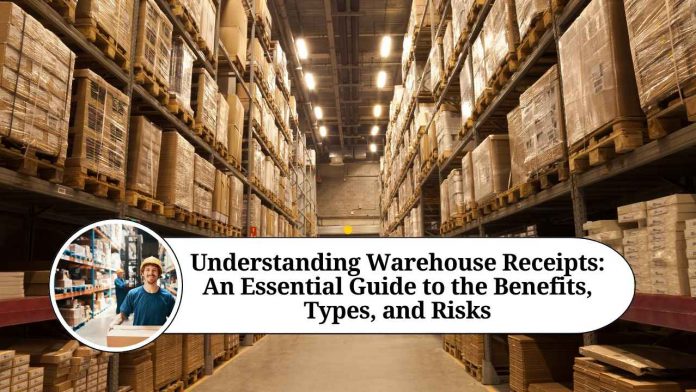Introduction:
Warehouse receipts are important financial instruments that are widely used in international trade, particularly in the agricultural and commodities sectors. In this blog, we’ll take a closer look at what warehouse receipts are, their benefits, and key features.
What is a Warehouse Receipt?
A warehouse receipt is a document issued by a warehouse operator to a depositor or owner of goods, indicating that specific goods are being held in the warehouse. Warehouse receipts serve as proof of ownership of the goods and can be used to obtain financing, settle trades, or transfer ownership.
Benefits of Warehouse Receipts
- Facilitate financing: Warehouse receipts can be used as collateral to obtain financing from banks and other financial institutions, allowing producers and traders to access capital to finance their operations.
- Enhance trade: Warehouse receipts can be used to settle trades between buyers and sellers, particularly in commodities trading, where physical delivery of goods may be delayed.
- Mitigate risk: Warehouse receipts can help mitigate the risk of loss or damage to goods by providing a secure storage facility and proof of ownership.
- Improve transparency: Warehouse receipts provide a transparent and auditable record of the movement and storage of goods, which can improve supply chain efficiency and reduce fraud.
Key Features of Warehouse Receipts
- Description of goods: Warehouse receipts should include a detailed description of the goods being held in the warehouse, including quantity, quality, and any distinguishing features.
- Name of owner/depositor: Warehouse receipts should clearly state the name of the owner or depositor of the goods, as well as any other relevant information, such as the date of deposit and the expiry date of the receipt.
- Warehouse operator details: Warehouse receipts should include the name and contact details of the warehouse operator, as well as any relevant information regarding the storage facility, such as location and capacity.
- Transferability: Warehouse receipts can be transferred from one owner to another, either through endorsement or delivery, making them a useful tool for trade and financing.
Types of Warehouse Receipts
There are two types of warehouse receipts: negotiable and non-negotiable. Negotiable warehouse receipts are transferable, meaning they can be bought, sold, or used as collateral for financing. Non-negotiable warehouse receipts, on the other hand, are not transferable and can only be redeemed by the original owner or depositor.
Requirements for Issuing Warehouse Receipts
To issue warehouse receipts, warehouse operators must comply with certain legal and regulatory requirements. These requirements vary depending on the jurisdiction, but typically include:
- Licensing: Warehouse operators must be licensed to operate by the relevant regulatory authority.
- Insurance: Warehouse operators must have adequate insurance coverage to protect against loss or damage to goods.
- Storage facilities: Warehouse operators must maintain secure storage facilities that comply with relevant safety and environmental standards.
- Record-keeping: Warehouse operators must keep accurate records of the movement and storage of goods, including the issuance and transfer of warehouse receipts.
Challenges and Risks Associated with Warehouse Receipts
While warehouse receipts offer a range of benefits, there are also several challenges and risks associated with their use. These include:
- Fraud: Warehouse receipts can be subject to fraud, particularly in jurisdictions with weak legal and regulatory frameworks.
- Counterparty risk: The use of warehouse receipts to obtain financing exposes lenders to counterparty risk, which is the risk that the borrower may default on their loan.
- Quality risk: If the goods being held in the warehouse are of poor quality or damaged, the value of the warehouse receipt may be significantly reduced.
Conclusion
Warehouse receipts are an important financial instrument in international trade, providing a range of benefits to producers, traders, and financiers. However, their use also poses several challenges and risks. By understanding the key features, types, requirements, and risks associated with warehouse receipts, stakeholders in the agricultural and commodities sectors can make informed decisions about using them to facilitate trade and financing.
Read more useful content:
Frequently Asked Questions (FAQs)
What is the purpose of a warehouse receipt?
A warehouse receipt serves as proof of ownership of goods that are being held in a warehouse. It can be used to obtain financing, settle trades, or transfer ownership.
Who issues warehouse receipts?
Warehouse receipts are issued by warehouse operators to depositors or owners of goods.
What types of goods can be covered by a warehouse receipt?
Warehouse receipts can cover a wide range of goods, including agricultural commodities, metals, and other raw materials.
How are warehouse receipts transferred?
Warehouse receipts can be transferred either through endorsement (i.e., signing over the receipt to another party) or through delivery of the physical receipt.
Can warehouse receipts be used as collateral for financing?
Yes, warehouse receipts can be used as collateral to obtain financing from banks and other financial institutions.
What is the difference between negotiable and non-negotiable warehouse receipts?
Negotiable warehouse receipts are transferable, meaning they can be bought, sold, or used as collateral for financing. Non-negotiable warehouse receipts, on the other hand, are not transferable and can only be redeemed by the original owner or depositor.
Are there any legal or regulatory requirements for issuing warehouse receipts?
Yes, warehouse operators must comply with certain legal and regulatory requirements, such as licensing, insurance, and record-keeping.
What risks are associated with using warehouse receipts?
The risks associated with using warehouse receipts include fraud, counterparty risk, and quality risk.
How can warehouse receipts help facilitate trade?
Warehouse receipts can help facilitate trade by providing a transparent and auditable record of the movement and storage of goods, which can improve supply chain efficiency and reduce fraud.
Are warehouse receipts widely used in international trade?
Yes, warehouse receipts are widely used in international trade, particularly in the agricultural and commodities sectors. They are recognized as an important financial instrument that can help facilitate trade and access to financing.















